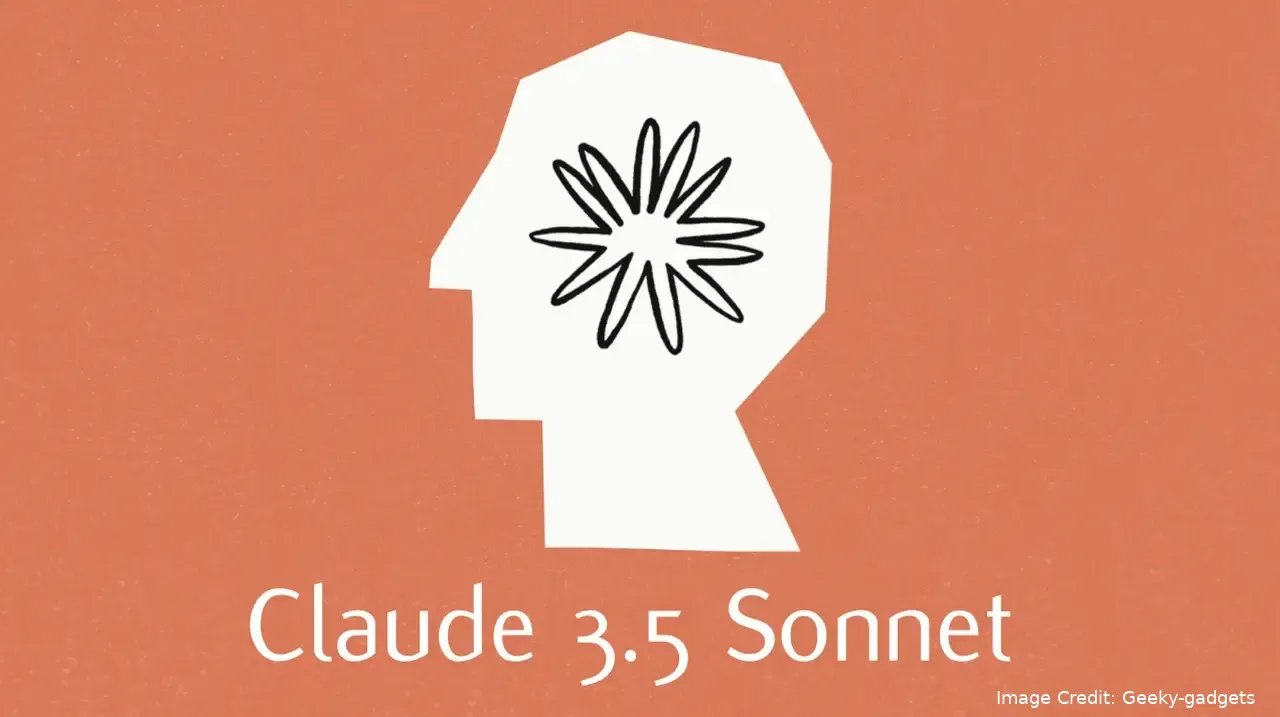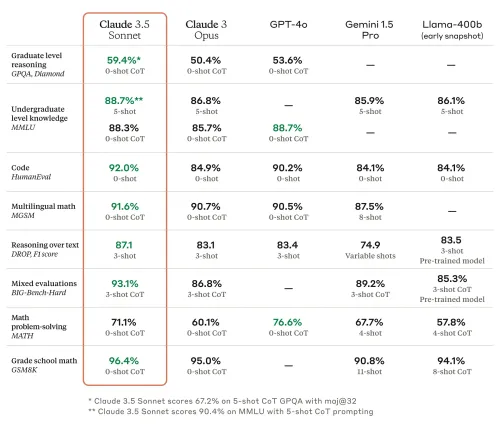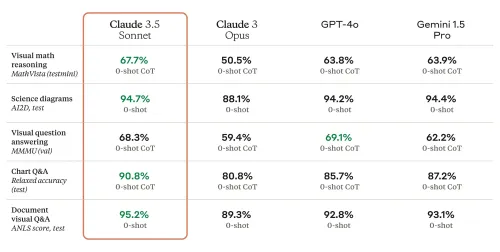
The landscape of artificial intelligence continues to evolve rapidly, with companies constantly pushing the boundaries of what's possible. Anthropic, a leading player in the field, recently unveiled the first member of its next-generation AI model family, the Claude 3.5 Sonnet. This innovative chatbot promises significant advancements in various tasks, potentially setting a new standard for AI performance.
Anthropic Unveils Claude 3.5 Sonnet: A New Benchmark in AI Capabilities
Beyond the Hype: Exploring Claude 3.5 Sonnet's Capabilities
Anthropic positions Claude 3.5 Sonnet as a versatile AI tool capable of tackling a wide range of challenges. From writing code to rendering visuals, the model demonstrates proficiency in numerous areas. Notably, it excels in tasks such as:
- Code Defect Detection: Claude 3.5 Sonnet exhibits a superior ability to identify and flag potential flaws within code, enhancing software development efficiency and security.
- Natural Language Understanding: The model effectively grasps the nuances of user input, enabling more accurate and contextually relevant responses.
- Mathematical Problem Solving: Claude 3.5 Sonnet tackles mathematical computations with impressive accuracy, demonstrating strong analytical capabilities.
While independent verification of Anthropic's benchmark results is still ongoing, the initial data suggests that Claude 3.5 Sonnet surpasses competing models like ChatGPT and Gemini in these specific areas.
Pushing the Boundaries of Vision and Information Extraction:
The advancements within Claude 3.5 Sonnet extend beyond traditional text-based tasks. Anthropic highlights the model's improved skills in visual reasoning and interpretation. This includes the ability to:
- Analyze Charts and Graphs: Claude 3.5 Sonnet can effectively extract insights from complex visual data, making it a valuable tool for understanding trends and patterns.
- Extract Text from Images: The model accurately transcribes text from imperfect images, a crucial capability for various industries, such as retail, logistics, and finance, where information often resides in both textual and visual formats.
These advancements indicate that Claude 3.5 Sonnet surpasses even Anthropic's previous flagship model, the Claude 3 Opus, in its visual processing capabilities.

Accessibility and Availability: A Multi-Tiered Approach
Understanding the diverse needs of users, Anthropic offers Claude 3.5 Sonnet with a tiered access structure. For a limited number of queries, the model is available for free, allowing users to experiment and experience its functionalities. For extended use, Anthropic provides subscription options like Claude Pro and Team, catering to users with higher usage requirements.
Looking Ahead: A Broader AI Ecosystem
The release of Claude 3.5 Sonnet marks a significant milestone for Anthropic, but it's only the beginning. The company hints at the upcoming arrival of two additional models later this year:
- Claude Opus, More Powerful: As the name suggests, a more powerful iteration of the Claude 3 Opus is anticipated, likely offering enhanced capabilities across various domains.
- Claude Haiku: Smaller and Faster: A smaller, more efficient model named Claude Haiku is also on the horizon. This model is expected to prioritize speed and resource efficiency while still delivering strong performance.
The introduction of multiple models with varying capabilities suggests Anthropic's commitment to providing a comprehensive AI solution. Users can choose the model that best aligns with their specific needs, whether it's maximizing power or prioritizing speed and resource constraints.
The Road to Responsible AI Advancement
As with any groundbreaking technology, responsible development and deployment remain paramount. Anthropic emphasizes that Claude 3.5 Sonnet adheres to its established "AI Safety Level 2" protocols, ensuring that the model operates within safe boundaries. Additionally, pre-deployment testing with independent institutions further strengthens the model's safety profile.
The Future of AI: Collaboration and Continuous Advancement
The unveiling of Claude 3.5 Sonnet is a testament to the ongoing progress in the field of AI. Anthropic's commitment to innovation, coupled with a focus on responsible development, paves the way for a future where AI can empower various sectors and improve our lives in profound ways. As other industry players continue to push the boundaries, a spirit of collaboration and knowledge sharing will be crucial in ensuring the ethical and beneficial advancement of artificial intelligence.

Deep Dive: A Technical Exploration of Claude 3.5 Sonnet
While the previous section provided a general overview of Claude 3.5 Sonnet's functionalities, delving deeper into its technical aspects can offer a more nuanced understanding of its potential impact.
Underlying Architecture and Training Data:
Specific details about Claude 3.5 Sonnet's architecture remain undisclosed by Anthropic. However, experts speculate that it likely builds upon the foundation of previous Claude models, potentially employing a large language model (LLM) architecture with advancements in specific areas. This could involve:
- Transformer-based Networks: These powerful neural network architectures excel at processing sequential data like text and code, allowing Claude 3.5 Sonnet to understand complex relationships within information.
- Attention Mechanisms: These mechanisms enable the model to focus on specific parts of the input data, enhancing its comprehension and ability to generate relevant responses.
- Supervised and Unsupervised Learning: A combination of techniques might be employed. Supervised learning involves training the model on labeled datasets, while unsupervised learning allows it to identify patterns in unlabeled data, potentially improving its ability to generalize.
The quality and quantity of training data are crucial factors influencing an AI model's performance. Anthropic likely utilizes massive datasets of text, code, images, and potentially other modalities to train Claude 3.5 Sonnet. This data encompasses diverse sources to ensure the model can handle real-world scenarios effectively.
Unlocking Potential Applications: A Sector-Specific Analysis
The diverse capabilities of Claude 3.5 Sonnet translate into a wide range of potential applications across numerous sectors. Let's explore some specific examples:
- Software Development: Claude 3.5 Sonnet's code analysis abilities can revolutionize software development workflows. Developers can leverage the model to identify and rectify potential bugs early in the development process, leading to more secure and efficient software creation.
- Scientific Research: The model's prowess in mathematical problem-solving can assist researchers in various scientific fields. It can analyze complex data sets, identify patterns, and potentially generate new hypotheses, accelerating scientific progress.
- Education and Training: Claude 3.5 Sonnet can personalize learning experiences by tailoring educational content to individual needs. Additionally, its ability to understand natural language makes it a valuable tool for developing interactive learning platforms.
- Customer Service: The model's ability to interpret user queries and generate natural language responses can transform customer service. It can handle routine inquiries, freeing human agents for more complex issues, and potentially offering 24/7 customer support.
- Content Creation: Claude 3.5 Sonnet can assist with various content creation tasks, such as writing different creative text formats, translating languages, and even generating basic image content based on textual descriptions. However, it's crucial to remember that human oversight and editorial control remain essential for ensuring quality and ethical content creation.
The Importance of Responsible AI Development
While the potential benefits of Claude 3.5 Sonnet are undeniable, responsible AI development remains a top priority. Here are some key considerations:
- Bias Mitigation: Training data can inadvertently contain biases that the model might perpetuate. Anthropic should continuously strive to mitigate bias in Claude 3.5 Sonnet and future models.
- Explainability and Transparency: Understanding how the model arrives at its outputs is crucial. Anthropic should develop mechanisms to explain the reasoning behind Claude 3.5 Sonnet's responses, fostering trust and enabling responsible use.
- Human-AI Collaboration: AI models are powerful tools, but they shouldn't replace human expertise. Claude 3.5 Sonnet should be used to augment human capabilities, not replace them.
The Ongoing Conversation: Collaboration and Future Directions
The development of AI models like Claude 3.5 Sonnet is a collaborative effort. Sharing best practices, research findings, and potential challenges openly among industry players is vital to ensure the ethical and beneficial advancement of AI.
Looking ahead, several key areas of exploration remain:
- Further Specialization: Can AI models become even more specialized in specific tasks, offering even greater efficiency and accuracy?
- Human-AI Interaction Design: How can we design intuitive interfaces for users to interact with AI models effectively, maximizing their potential benefits?
- The Broader Societal Impact: How can we ensure that AI advancements contribute to a more equitable and sustainable future for all?
Conclusion: A Catalyst for Progress
The unveiling of Claude 3.5 Sonnet signifies a significant leap forward in AI capabilities. This model, along with the upcoming Claude Opus and Haiku, offers a promising glimpse into the future of AI. By fostering responsible development, open communication, and collaboration, we can harness the power of AI to tackle significant challenges and create a brighter future for humanity.
Popular News
Latest News
Loading






